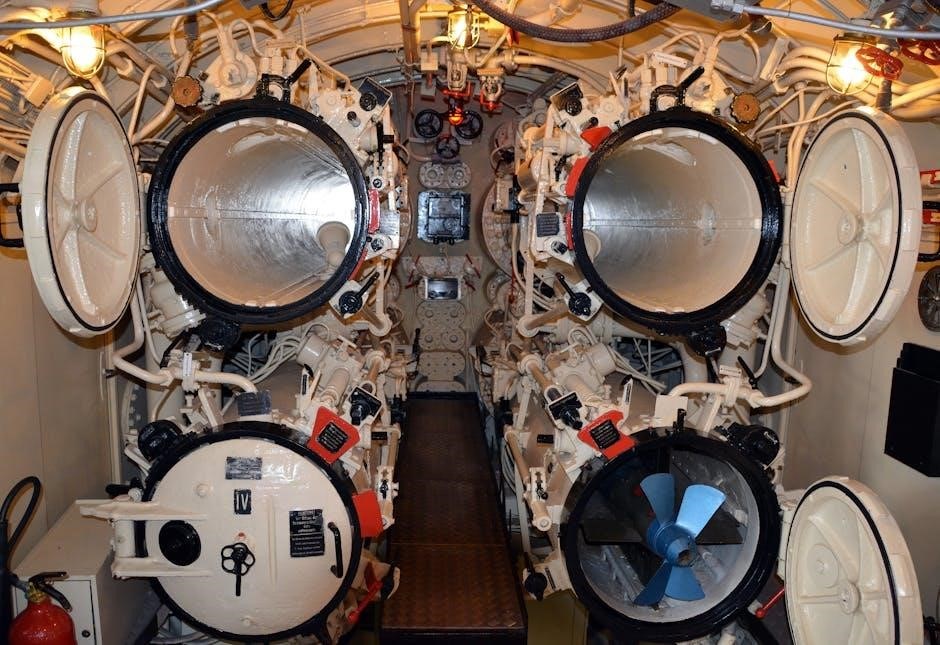Overview of Naval Ships Technical Manual 670
The Naval Ships Technical Manual 670 provides standardized practices and guidelines for the design, construction, and operation of naval vessels, ensuring safety and compliance with regulations.
1.1 Purpose and Scope
The Naval Ships Technical Manual 670 is designed to establish uniform engineering and operating standards for naval vessels, ensuring safety, efficiency, and compliance with regulatory requirements. Its purpose is to provide clear guidelines for ship design, construction, and maintenance, addressing both operational and technical aspects. The manual serves as a foundational document for personnel involved in naval operations, including engineers, officers, and maintenance crews. It covers a wide range of topics, from propulsion systems to environmental regulations, ensuring that all practices align with international maritime standards. The scope includes detailed specifications, best practices, and compliance measures to maintain the integrity and functionality of naval ships.
1.2 Structure and Organization
The Naval Ships Technical Manual 670 is organized into clear, logically structured sections to ensure easy reference and comprehensive coverage of critical topics. The manual is divided into six primary sections, each addressing distinct aspects of naval ship operations and maintenance. These sections include an overview, regulatory frameworks, technical specifications, safety procedures, operational guidelines, and updates. Within each section, detailed chapters and subsections provide in-depth information, supported by diagrams, tables, and appendices. This systematic approach allows users to quickly locate relevant information, ensuring efficient application of the guidelines. The manual’s structure is designed to accommodate updates and revisions, maintaining its relevance and effectiveness over time.

Regulatory Framework and Compliance
Naval Ships Technical Manual 670 ensures adherence to international and national maritime regulations, including safety, environmental, and operational standards, to maintain legal and operational integrity at sea.

2.1 Safety Standards and Regulations
Naval Ships Technical Manual 670 outlines rigorous safety standards to ensure vessel integrity and crew protection. It aligns with international maritime regulations, including SOLAS and MARPOL, to prevent accidents and environmental harm. The manual specifies requirements for life-saving appliances, fire protection systems, and emergency response protocols. Compliance with these standards is mandatory, ensuring operational safety and preparedness for unforeseen incidents. Regular inspections and maintenance schedules are emphasized to uphold safety practices. Crew training and drills are also highlighted to enhance emergency readiness, reflecting a comprehensive approach to maritime safety and regulatory adherence.
2.2 Classification Societies and Certifications
Naval Ships Technical Manual 670 emphasizes the role of classification societies in ensuring vessel compliance with safety and design standards. These organizations, such as Lloyd’s Register or ABS, provide certifications that validate a ship’s structural integrity, mechanical systems, and operational readiness. The manual requires adherence to these certifications to maintain seaworthiness and compliance with international maritime regulations. Classification societies conduct rigorous inspections and audits to verify conformity, ensuring that naval ships meet stringent safety, environmental, and performance criteria. Certifications are periodically renewed to reflect updates in technology and regulatory requirements, ensuring ongoing compliance and operational reliability.

Technical Specifications and Design

Naval Ships Technical Manual 670 outlines detailed specifications for vessel design, construction, and propulsion systems, ensuring adherence to material standards and layout requirements for optimal performance and safety.
3.1 Vessel Design and Construction
Naval Ships Technical Manual 670 provides comprehensive guidelines for the design and construction of naval vessels, emphasizing structural integrity, material quality, and adherence to safety standards. It outlines specifications for hull design, compartmentalization, and load calculations to ensure seaworthiness and operational efficiency. The manual also addresses environmental considerations, such as reducing emissions and minimizing waste, aligning with modern maritime regulations. Detailed requirements for welding, coatings, and corrosion control are included to prolong vessel lifespan. Compliance with these standards ensures naval ships are built to withstand harsh marine conditions while maintaining peak performance and crew safety. Regular updates reflect advancements in naval engineering and materials science.
3.2 Propulsion and Power Systems
Naval Ships Technical Manual 670 details the specifications and requirements for propulsion and power systems, ensuring efficient and reliable operation. It covers engine types, fuel management, and propulsion shafts, emphasizing performance and environmental compliance. The manual includes guidelines for power generation, distribution, and energy storage systems, such as batteries and generators. It also addresses noise reduction and vibration control to maintain stealth and operational efficiency. Regular inspections and maintenance protocols are outlined to ensure system longevity. Compliance with these standards ensures naval vessels achieve optimal performance while adhering to safety and environmental regulations. Advanced technologies, such as diesel-electric propulsion, are also addressed to meet modern maritime demands.
3.3 Electrical and Electronic Systems
Naval Ships Technical Manual 670 provides detailed guidelines for the design, installation, and maintenance of electrical and electronic systems aboard naval vessels. These systems include power distribution, navigation aids, communication equipment, and control panels. The manual emphasizes safety standards, redundancy, and fail-safe mechanisms to ensure uninterrupted operations. It also covers electromagnetic compatibility to prevent interference between systems. Regular testing and inspection protocols are outlined to maintain system reliability. Compliance with these specifications ensures optimal performance, crew safety, and adherence to maritime regulations. Advanced technologies, such as automated monitoring systems, are integrated to enhance efficiency and reduce human error, aligning with modern naval operational demands.

Safety Procedures and Protocols
Naval Ships Technical Manual 670 outlines critical safety procedures, including emergency response plans, evacuation protocols, and regular safety drills to ensure crew preparedness and vessel integrity.
4.1 Emergency Response and Evacuation
Naval Ships Technical Manual 670 details comprehensive emergency response and evacuation protocols to ensure crew safety. It includes procedures for fire, flooding, and other critical incidents. Regular drills are mandated to prepare crew for emergencies, emphasizing swift and organized evacuation. The manual specifies the use of alarm systems, emergency lighting, and clear evacuation routes. Life-saving appliances, such as lifeboats and life rafts, must be readily accessible and regularly inspected. Communication protocols during emergencies are outlined to maintain coordination between crew and external rescue teams. These measures aim to minimize risks and ensure timely evacuation, safeguarding both personnel and vessel integrity in crisis situations.

4.2 Maintenance and Inspection Requirements
Naval Ships Technical Manual 670 outlines rigorous maintenance and inspection schedules to ensure vessel operational readiness and safety. Regular inspections of propulsion, electrical, and safety systems are mandated. Maintenance tasks include lubrication, component replacements, and corrosion control. Detailed record-keeping is required to track compliance and system health. Classification societies often certify maintenance procedures, ensuring adherence to international standards; Crews must follow prescribed intervals for inspections and report any discrepancies promptly. Proper maintenance prevents system failures and ensures compliance with safety regulations, safeguarding both the crew and the vessel’s operational integrity. These procedures are essential for extending the service life of naval ships and maintaining peak performance levels at all times.
4.3 Environmental and Pollution Regulations
Naval Ships Technical Manual 670 emphasizes compliance with environmental and pollution regulations to minimize ecological impact. Vessels must adhere to strict guidelines for waste management, discharge control, and emissions reduction. The manual outlines procedures for handling hazardous materials, preventing oil spills, and ensuring proper disposal of waste. Compliance with international treaties, such as MARPOL, is mandatory. Regular inspections and audits are conducted to verify adherence to these regulations. Crews are trained to recognize and mitigate environmental risks, ensuring sustainable operations at sea. Proper documentation and reporting of environmental incidents are also required to maintain accountability and transparency in naval operations.

Operational Guidelines and Best Practices
Naval Ships Technical Manual 670 outlines operational guidelines and best practices for efficient vessel management, ensuring safety, environmental compliance, and adherence to established protocols.
5.1 Crew Training and Competency
Naval Ships Technical Manual 670 emphasizes the importance of comprehensive crew training programs to ensure operational readiness and safety. Crew members must adhere to standardized guidelines, undergo regular drills, and stay updated with the latest manual revisions to maintain competency. Proper training ensures effective handling of emergencies and routine operations, aligning with regulatory requirements. Continuous education and practical exercises are essential for fostering a skilled and responsive team. Adherence to these protocols guarantees optimal performance and compliance with safety standards, minimizing risks at sea. Crew competency is a cornerstone of successful naval operations, as outlined in the manual.
5.2 Watchkeeping and Navigation
Naval Ships Technical Manual 670 outlines strict protocols for watchkeeping and navigation to ensure safe and efficient maritime operations. Officers on duty must maintain vigilant monitoring of vessel position, heading, and speed, utilizing advanced navigation tools like GPS, radar, and electronic charts. Adherence to established protocols minimizes collision risks and ensures compliance with international maritime laws. Regular drills and scenario simulations are mandated to enhance crew preparedness for diverse navigational challenges. Effective communication between bridge personnel is emphasized to maintain situational awareness, particularly in high-traffic or adverse weather conditions. These practices are essential for safeguarding crew, passengers, and cargo while upholding operational integrity.
5.3 Communication and Alarm Systems
Naval Ships Technical Manual 670 emphasizes the importance of reliable communication and alarm systems for crew safety and effective operations. Vessels must be equipped with advanced communication technologies, including VHF radios, satellite links, and internal intercom systems, ensuring seamless connectivity between crew members and external entities. Alarm systems are rigorously tested to alert personnel of emergencies such as fires, flooding, or system failures. These systems must adhere to international maritime standards, providing clear and timely alerts to prevent accidents. Regular maintenance and crew training on these systems are mandated to ensure optimal functionality and rapid response capabilities during critical situations, safeguarding both personnel and the vessel.

Updates and Revisions
Naval Ships Technical Manual 670 undergoes periodic revisions to incorporate advancements, address feedback, and align with evolving maritime standards and operational requirements, ensuring continuous improvement and compliance.
6.1 Revision History and Changes

The revision history of Naval Ships Technical Manual 670 details updates, modifications, and clarifications made to ensure compliance with new safety standards and operational practices. Changes include updates to safety protocols, incorporation of new technologies, and alignment with revised regulatory requirements. Each revision is documented with version control, enabling users to track updates efficiently. The manual is periodically reviewed and updated by relevant authorities to reflect industry advancements and address user feedback, ensuring it remains a comprehensive and reliable resource for naval operations. This structured approach ensures ongoing relevance and operational safety. Compliance with updates is mandatory.
6.2 Process for Submitting Revisions
The process for submitting revisions to Naval Ships Technical Manual 670 involves formalized procedures to ensure accuracy and compliance. Proposed changes must be submitted through designated channels, using standardized forms and documentation. Submissions are reviewed by a technical committee to assess their validity, impact, and alignment with current standards. Approvals are granted based on rigorous criteria, ensuring updates enhance safety, functionality, or regulatory compliance. Once approved, revisions are incorporated into the manual and distributed to relevant stakeholders. This structured process ensures transparency and maintains the manual’s reliability as a critical resource for naval operations. Adherence to these procedures is mandatory for all contributors.
